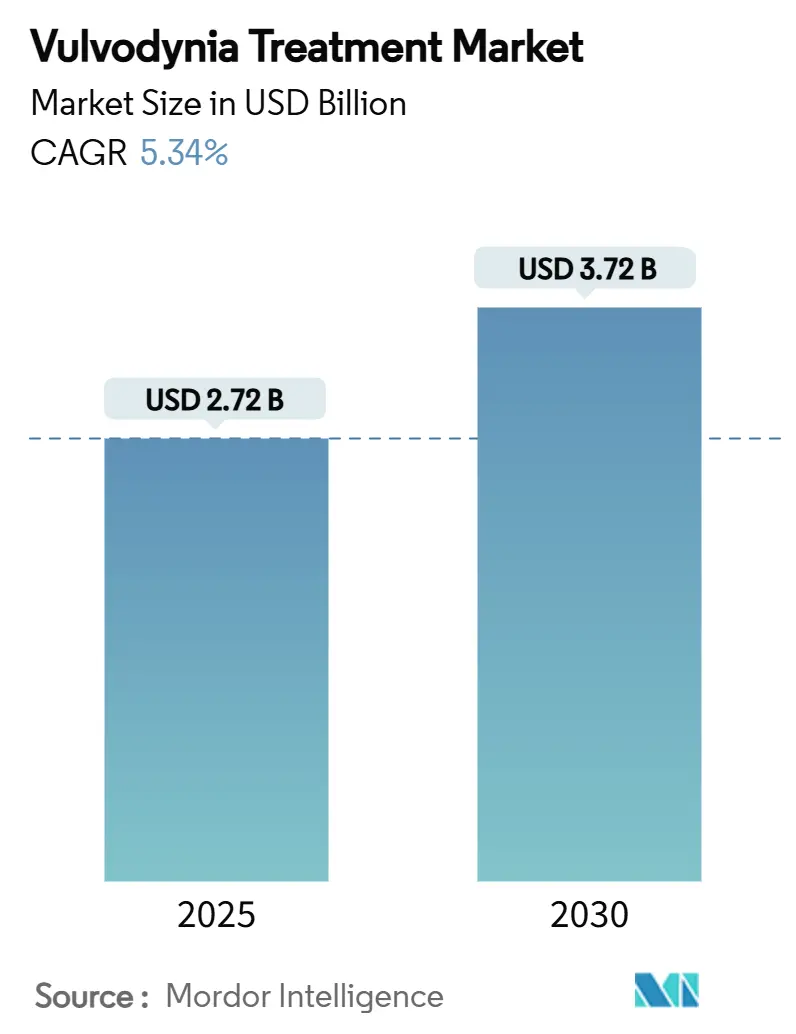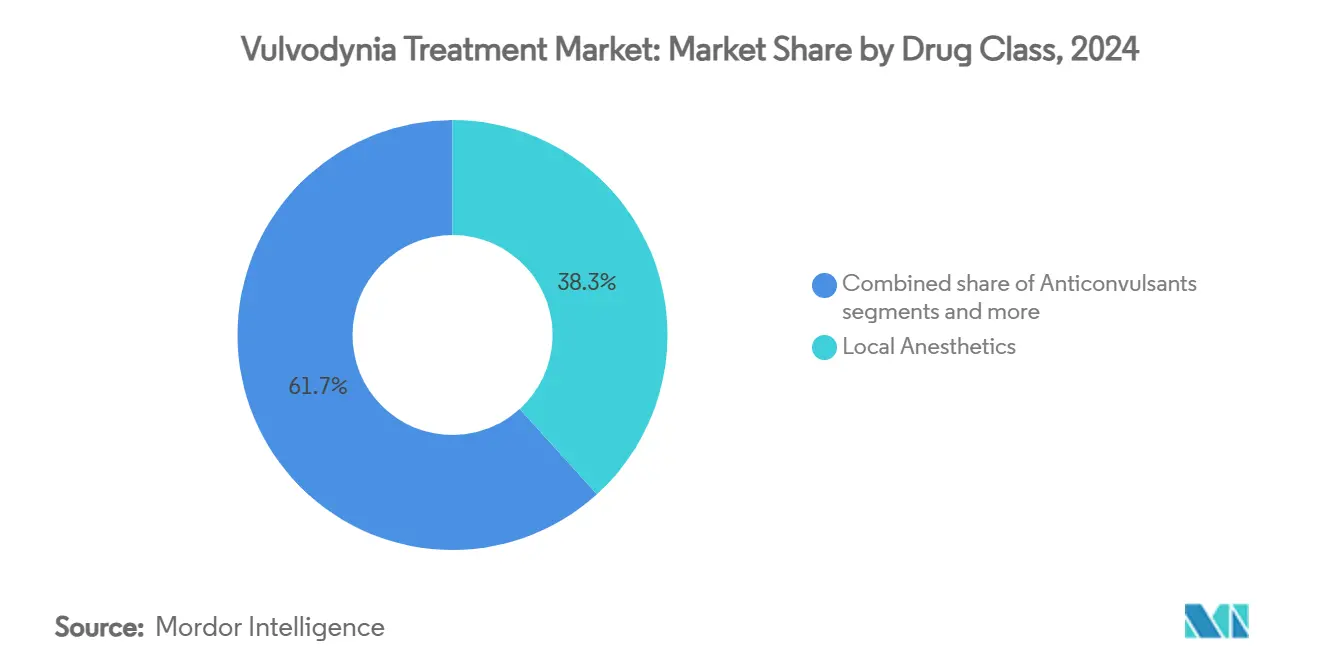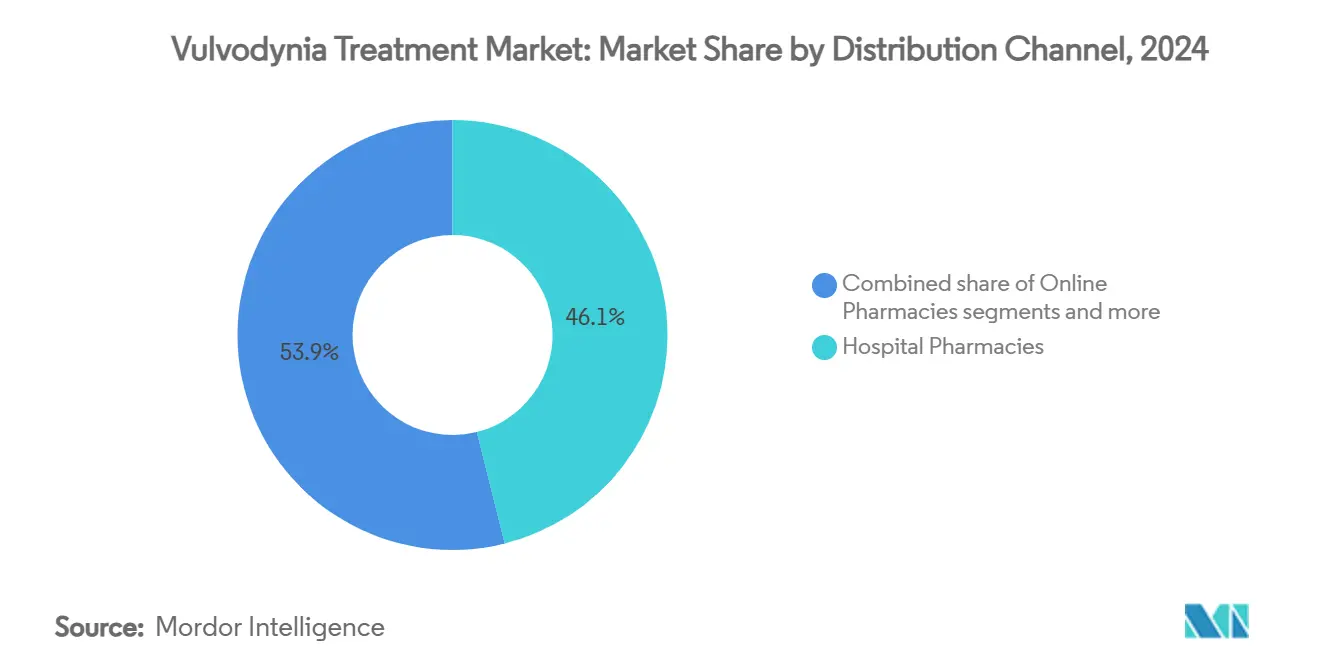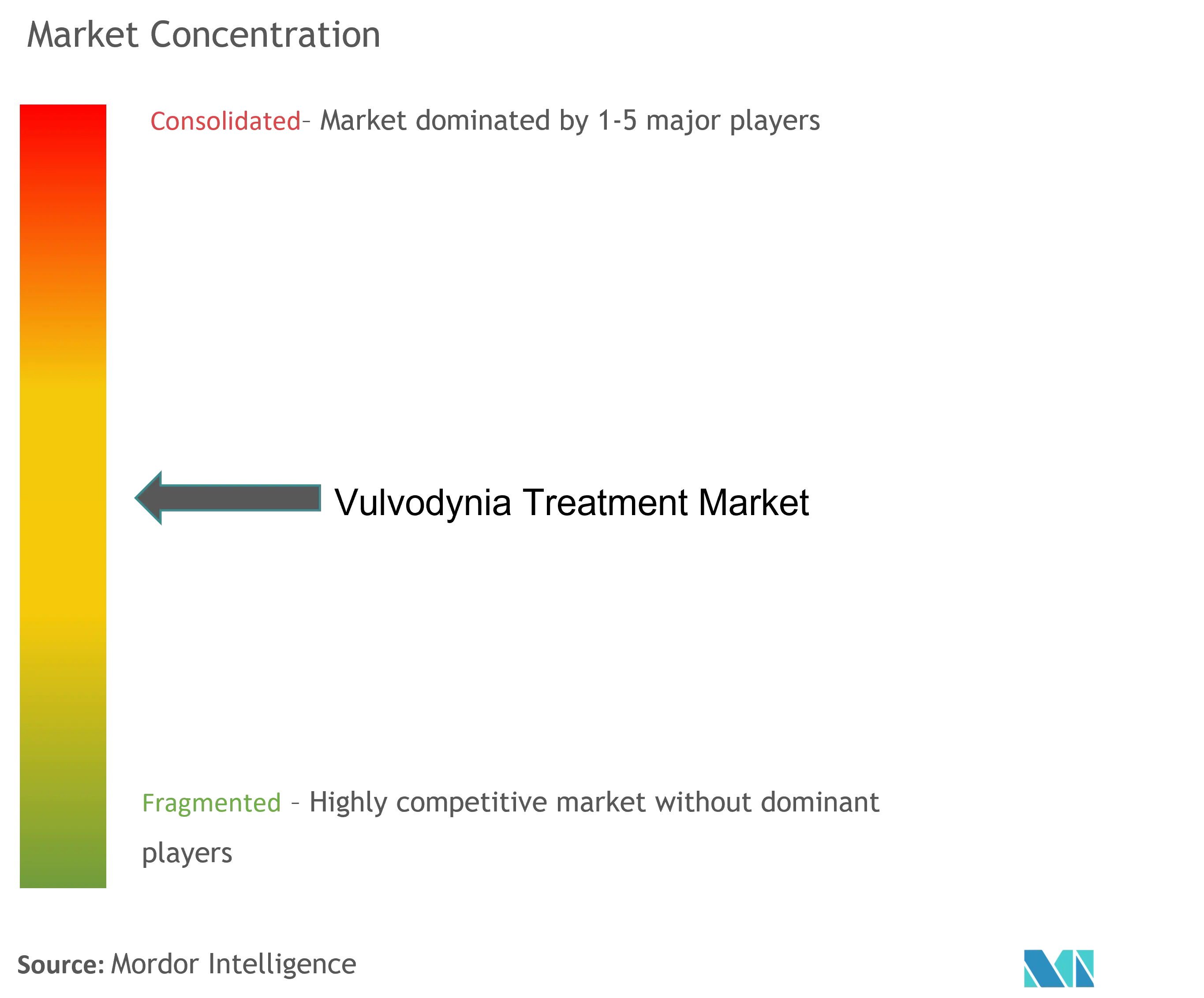Vulvodynia Treatment Market Size and Share

Vulvodynia Treatment Market Analysis by Mordor Intelligence
The vulvodynia treatment market size reached USD 2.72 billion in 2025 and is forecast to register USD 3.72 billion by 2030, translating into a 5.34% CAGR over the period. The sustained uptick reflects stronger diagnostic protocols, broader public-health outreach, and expanding therapeutic innovation. Rising prevalence estimates that up to 16% of women experience chronic vulvar pain and increasing clinician acknowledgment are boosting patient inflows. Improved muco-adhesive delivery technologies, surging telehealth adoption, and consolidation moves among women’s-health manufacturers are further lifting revenue potential. Local anesthetics remain entrenched as first-line care because of rapid relief and limited systemic exposure, while neuromodulatory classes such as SNRIs are advancing in line with growing acceptance of central sensitization theories.
Key Report Takeaways
- By drug class, local anesthetics led with 38.27% of vulvodynia treatment market share in 2024 while SNRIs posted the highest projected CAGR at 5.92% through 2030.
- By route of administration, topical products captured 62.93% share of the vulvodynia treatment market size in 2024; transdermal films are set to expand at a 6.29% CAGR between 2025 and 2030.
- By distribution channel, hospital pharmacies accounted for 46.10% share of the vulvodynia treatment market size in 2024, whereas online pharmacies are advancing at a 6.68% CAGR to 2030.
- By geography, North America held 42.23% revenue share in 2024 and Asia-Pacific is projected to record a 7.10% CAGR, the fastest among all regions, through 2030.
Global Vulvodynia Treatment Market Trends and Insights
Driver Impact Analysis
| Driver | (~) % Impact on CAGR Forecast | Geographic Relevance | Impact Timeline |
|---|---|---|---|
| Rising prevalence & better diagnosis rates | +1.2% | Global, with early gains in North America & Europe | Medium term (2-4 years) |
| Awareness campaigns by women's-health NGOs | +0.8% | Global, spill-over to emerging markets | Long term (≥ 4 years) |
| Greater adoption of topical anesthetics (5% lidocaine, etc.) | +1.0% | North America & EU core, expansion to APAC | Short term (≤ 2 years) |
| Expansion of e-commerce & tele-prescription channels | +0.9% | Global, accelerated in APAC and emerging markets | Medium term (2-4 years) |
| High-intensity laser therapy (HILT) clinics gaining traction | +0.7% | North America & EU, selective APAC markets | Long term (≥ 4 years) |
| Pipeline muco-adhesive thin films for rapid drug delivery | +0.6% | Global, pending regulatory approvals | Long term (≥ 4 years) |
| Source: Mordor Intelligence | |||
Rising Prevalence and Better Diagnosis Rates
Clinical surveys now place lifetime vulvodynia prevalence between 8% and 16%, a figure long underestimated because of diagnostic ambiguity. New American College of Obstetricians and Gynecologists guidelines promote standardized pain assessment during routine pelvic exams, pushing earlier case recognition. Dedicated vulvovaginal disorder clinics in the United States and Germany report 40%–60% higher detection after embedding validated pain scales into electronic health records. Heightened detection broadens the patient base, incentivizing pipeline investment across topical and systemic therapies.
Greater Adoption of Topical Anesthetics
A 5% lidocaine formulation remains the frontline agent because it delivers quick relief without systemic adverse events. Specialty compounding firms now combine lidocaine with prilocaine or gabapentin, responding to 15% of patients who require extended analgesia. The American Academy of Dermatology reported that proactive FDA engagement solved the 2024 lidocaine shortage, restoring a stable supply chain for topical anesthetics.
Expansion of E-commerce and Tele-prescribing
Sensitive patient populations gravitate toward digital pathways that provide confidentiality and doorstep delivery. Online pharmacies specializing in women’s health logged a 6.68% CAGR for vulvodynia prescriptions in 2024 while integrating HSA/FSA payment options to lower out-of-pocket costs. Telemedicine networks also connect rural clinics to metropolitan vulvar pain specialists, shrinking diagnostic wait times from six months to six weeks.
Awareness Campaigns by Women’s-Health NGOs
Organizations such as the National Vulvodynia Association leverage social media, webinars, and clinician toolkits to destigmatize vulvar pain. Campaigns reach 2 million users annually and drive measurable jumps in search queries for “vulvar pain treatment” across India, Brazil, and Nigeria[1]Source: National Vulvodynia Association, “Vulvodynia Treatments,” nva.org . The resulting dialogue nudges policymakers to update benefit designs, which gradually improves insurance coverage for multidisciplinary care.
Restraint Impact Analysis
| Restraint | (~) % Impact on CAGR Forecast | Geographic Relevance | Impact Timeline |
|---|---|---|---|
| Absence of FDA-approved vulvodynia-specific drugs | -1.8% | Global, most acute in regulated markets | Long term (≥ 4 years) |
| Limited reimbursement for multimodal regimens | -1.3% | North America & EU, expanding to other regions | Medium term (2-4 years) |
| Heterogeneous etiology complicates treatment protocols | -0.9% | Global, particularly challenging in emerging markets | Medium term (2-4 years) |
| Periodic API shortages of lidocaine & price spikes | -0.7% | Global, with acute supply chain vulnerabilities | Short term (≤ 2 years) |
| Source: Mordor Intelligence | |||
Absence of FDA-Approved Vulvodynia-Specific Drugs
Therapies are prescribed off-label, creating reimbursement uncertainty and constraining promotional activities. A National Institutes of Health comparative study enrolling 400 women at Duke University seeks to generate head-to-head evidence but final results will not emerge before 2027. The regulatory vacuum slows uptake of novel molecules, dampening the vulvodynia treatment market growth potential despite strong clinical need.
Limited Reimbursement for Multimodal Regimens
Optimal care blends pharmacotherapy, pelvic-floor physiotherapy, psychological counseling, and sometimes laser or injectables. Payer policies typically reimburse single interventions rather than integrated programs, forcing patients to shoulder up to USD 5,000 in annual out-of-pocket costs in the United States [2]Source: Partum Health, “Pelvic Floor Therapy Coverage,” partumhealth.com . Emerging value-based bundles piloted by university hospitals aim to prove cost offsets through reduced repeat visits and enhanced quality-of-life metrics.
Segment Analysis
By Drug Class: Local Anesthetics Retain Command as SNRIs Accelerate
The segment registered a 38.27% share in 2024, underscoring the entrenched preference for lidocaine-centered regimens that offer localized and rapid relief. This leadership is poised to persist given continued physician confidence and patient familiarity. However, SNRIs post the fastest 5.92% CAGR, reflecting mounting evidence that duloxetine modulates central pain pathways and improves comorbid mood disorders. Anticonvulsants maintain niche relevance, though cardiovascular safety alerts for gabapentin and pregabalin temper near-term acceleration. Tricyclic antidepressants, led by amitriptyline, exhibit stable demand supported by 59.3% responder rates. Hormonal therapies, notably topical estradiol for post-menopausal vulvodynia, re-enter clinician toolkits as supportive evidence grows.
Continued preference for local anesthetics feeds a robust compounding ecosystem that crafts lidocaine-prilocaine blends, thereby reinforcing pharmacist engagement in care pathways. Meanwhile, biotechnology firms pursue injectable innovations such as botulinum toxin for spastic pelvic-floor musculature. These novel modalities could capture incremental share but will rely on clinician education given procedural learning curves.

Note: Segment shares of all individual segments available upon report purchase
By Route of Administration: Topical Dominance Faces Transdermal Innovation
Topical formulations accounted for 62.93% of the vulvodynia treatment market size in 2024, mirroring widespread endorsement of localized therapy among gynecologists and dermatologists. Patient self-administration and the capacity to titrate dose frequency underpin enduring uptake. Transdermal films, although nascent, display a 6.29% CAGR and promise improved adherence via extended drug residence. Oral systemic therapies preserve relevance for centrally mediated pain yet encounter adherence hurdles tied to dizziness, somnolence, or gastrointestinal distress. Injectable options, spearheaded by botulinum toxin and platelet-rich plasma, command specialist attention in tertiary centers but remain niche in volumes.
Breakthrough thin-film products, once cleared, could peel share from conventional creams by offering mess-free application. Manufacturers are also experimenting with vaginal suppositories integrating baclofen, currently under a Phase 2 protocol at the University of Louisville, to tackle overlapping pelvic-pain syndromes. These innovations foreshadow an evolving competitive stack in administration routes.
By Distribution Channel: Hospital Pharmacies Lead Digital Transformation
Hospital pharmacies held 46.10% share in 2024, reflecting the heavy diagnostic and multidisciplinary nature of vulvodynia care. Onsite compounding, direct clinician interface, and access to device-based adjuncts reinforce their primacy. Yet online pharmacies exhibit the liveliest 6.68% CAGR, catalyzed by patient demand for privacy, logistical convenience, and integrated tele-prescription workflows. Retail chains sustain presence but lag innovation, partly due to limited pharmacist specialization in chronic vulvar pain.
The rise of e-commerce platforms focusing on women’s sexual health augments market reach into rural geographies and culturally conservative societies. Several hospitals now partner with digital pharmacies to maintain continuity of supply after discharge, merging clinical oversight with at-home convenience.

Geography Analysis
North America generated 42.23% of 2024 revenue, powered by dense networks of vulvar pain clinics, academic research funding, and broad insurer coverage for evidence-based treatments. Cross-border telehealth linkages are shortening waitlists, while FDA fast-track designations for women’s-health drugs could further energize the region’s pipeline.
Asia-Pacific is projected to record a 7.10% CAGR through 2030, the briskest worldwide. Rising disposable income, public campaigns that normalize conversations about intimate health, and accelerated smartphone penetration collectively broaden access to virtual consults and online pharmacies. Government-sponsored women’s-health programs in China and India finance pelvic-floor therapy pilot projects, signaling policy momentum.
Europe maintains steady growth anchored by universal coverage. Germany and the United Kingdom lead clinical trial density, although stringent reimbursement review slows the adoption of premium-priced innovations. South America and the Middle East & Africa remain early-stage. Urban Brazil witnesses growth in private women’s-health clinics, whereas rural sub-Saharan Africa struggles with cultural taboos and clinician shortages.
Competitive Landscape
Competitive intensity remains moderate with no player surpassing double-digit individual revenue. Big-pharma companies leverage existing neuropathic-pain portfolios but face indication-specific marketing restrictions. Cosette Pharmaceuticals’ USD 430 million purchase of Mayne Pharma adds 12 patent-protected women’s-health assets, signaling momentum toward focused portfolios. Daré Bioscience readies a Phase 3 trial for Sildenafil Cream 3.6% aimed at female sexual arousal disorder yet poised for off-label vulvodynia spin-offs.
Strategic imperatives include securing FDA approvals to shift from off-label to on-label promotion, integrating telehealth platforms to capture e-commerce growth, and investing in muco-adhesive films that promise competitive differentiation. Technology start-ups deliver symptom-tracking apps and patient communities, generating real-world data that feed clinical-development algorithms. Meanwhile, academic-industry consortia pursue regenerative therapies such as platelet-rich plasma, an area under investigation at Mayo Clinic. Overall, the arena is primed for alliances that unite pharmacologic innovation with digital-engagement capabilities.
Vulvodynia Treatment Industry Leaders
Upsher-Smith Laboratories
Viatris Inc.
Cadila Pharmaceuticals
Bayer AG
Stada Arzneimittel AG
- *Disclaimer: Major Players sorted in no particular order

Recent Industry Developments
- January 2025: WHAM estimated a USD 66 billion women’s-health opportunity by 2033, highlighting vulvodynia gaps.
- November 2024: CenterWatch began recruiting 100 participants for the StrataMGT vulvar lichen sclerosus study
Global Vulvodynia Treatment Market Report Scope
As per the scope of this report, vulvodynia, or pain in the vulva, is a chronic condition characterized by burning, stinging, and stabbing sensations. The treatment for vulvodynia includes avoiding irritants such as tight-fitting clothing, perfumes, and dyes, as well as medications such as local anesthetic and nerve medication, among other medications. The Vulvodynia Treatment Market is Segmented by Drug Type (Local Anesthetics, Anticonvulsants, Tricyclic Antidepressants, Antimicrobials, and Other Drug Types), Mode of Administration (Oral, Topical, and Injectable), Distribution Channel (Hospital Pharmacies, Retail Pharmacies, and Other Distribution Channels), and Geography (North America, Europe, Asia-Pacific, Middle-East and Africa, and South America). The market report also covers the estimated market sizes and trends for 17 different countries across major regions globally. The report offers the value (in USD million) for the above-mentioned segments.
| Local Anesthetics |
| Anticonvulsants |
| Tricyclic Antidepressants |
| SNRIs |
| Hormonal Therapies |
| Others |
| Topical |
| Oral |
| Injectable |
| Others |
| Hospital Pharmacies |
| Retail Pharmacies & Drug Stores |
| Online Pharmacies |
| North America | United States |
| Canada | |
| Mexico | |
| Europe | Germany |
| United Kingdom | |
| France | |
| Italy | |
| Spain | |
| Rest of Europe | |
| Asia-Pacific | China |
| India | |
| Japan | |
| South Korea | |
| Australia | |
| Rest of Asia-Pacific | |
| South America | Brazil |
| Argentina | |
| Rest of South America | |
| Middle East and Africa | GCC |
| South Africa | |
| Rest of Middle East and Africa |
| By Drug Class | Local Anesthetics | |
| Anticonvulsants | ||
| Tricyclic Antidepressants | ||
| SNRIs | ||
| Hormonal Therapies | ||
| Others | ||
| By Route of Administration | Topical | |
| Oral | ||
| Injectable | ||
| Others | ||
| By Distribution Channel | Hospital Pharmacies | |
| Retail Pharmacies & Drug Stores | ||
| Online Pharmacies | ||
| By Geography | North America | United States |
| Canada | ||
| Mexico | ||
| Europe | Germany | |
| United Kingdom | ||
| France | ||
| Italy | ||
| Spain | ||
| Rest of Europe | ||
| Asia-Pacific | China | |
| India | ||
| Japan | ||
| South Korea | ||
| Australia | ||
| Rest of Asia-Pacific | ||
| South America | Brazil | |
| Argentina | ||
| Rest of South America | ||
| Middle East and Africa | GCC | |
| South Africa | ||
| Rest of Middle East and Africa | ||
Key Questions Answered in the Report
What is the current value of the vulvodynia treatment market?
The vulvodynia treatment market size stood at USD 2.72 billion in 2025.
What CAGR is projected for the vulvodynia treatment market between 2025 and 2030?
The market is forecast to grow at a 5.34% CAGR during 2025-2030.
Which drug class holds the largest share of the vulvodynia treatment market?
Local anesthetics lead with 38.27% share in 2024.
Which geographic region is expected to grow fastest in the vulvodynia treatment market?
Asia-Pacific is projected to record the highest 7.10% CAGR through 2030.
Why is reimbursement a restraint for vulvodynia therapies?
Payers often cover single treatments but not full multimodal regimens, leaving patients to pay significant out-of-pocket costs.
What recent acquisition signals consolidation in vulvodynia therapeutics?
Cosette Pharmaceuticals acquired Mayne Pharma for USD 430 million in February 2025 to bolster its womens-health portfolio.



